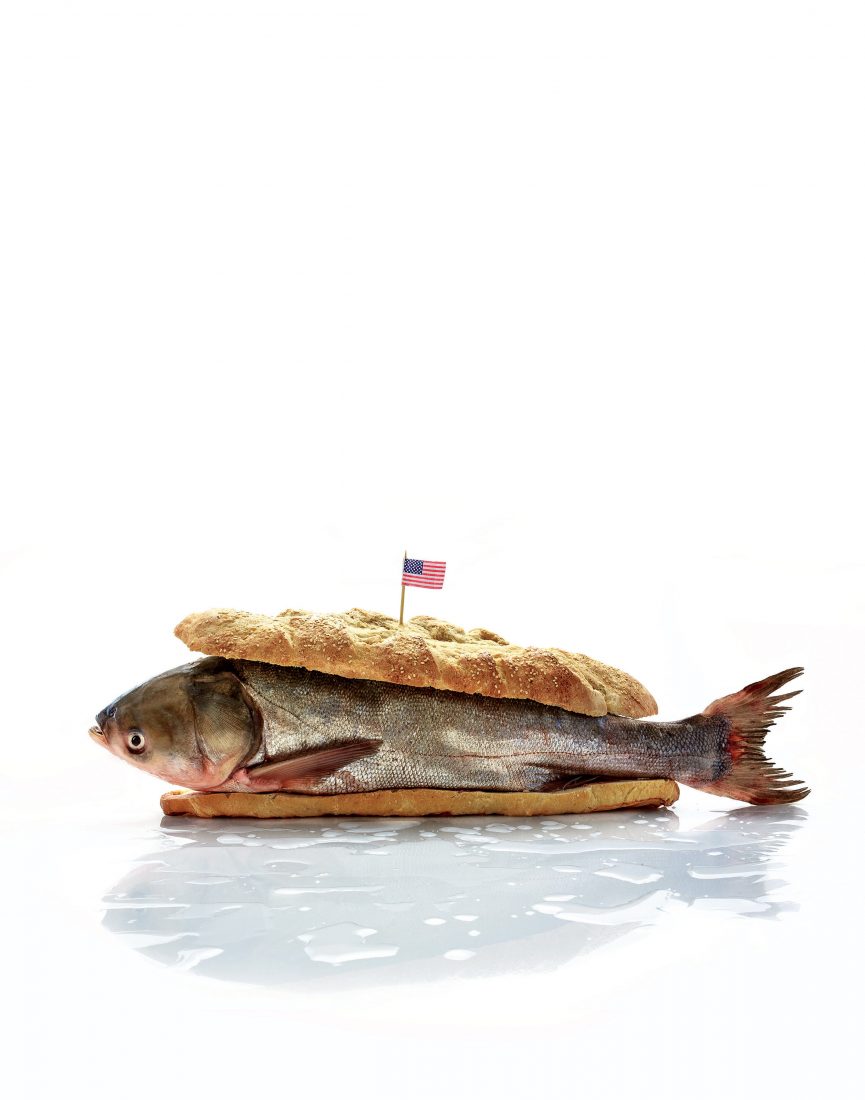This past fall I arrived in Jackson, Mississippi, to find Paul and Libby Hartfield in the middle of a disagreement.
“Libby says if you wanna call something a fillet it has to be boneless,” Paul exclaimed, trying to win me over to his side. “I told her, ‘Libby, I filleted that carp just like you fillet any fish. Just ’cause it’s got bones doesn’t mean it isn’t filleted.’”
For the Hartfields, Asian carp come up regularly, in conversation, on the dinner table, and in the many over-the-top flying Asian carp Internet videos folks in the Mississippi valley tend to share with one another. (You might have seen a few, too.) Paul Hartfield is a biologist with the U.S. Fish and Wildlife Service whose job is to cruise the Mississippi monitoring the dozens of fish species that call it home. Libby, his wife of more than three decades, is the director of the Mississippi Museum of Natural Science and a biologist with equal experience in the ecology of Old Man River. And while they occasionally disagree on semantic issues, they agree that the silver and bighead carp, along with several other species collectively called Asian carp, are a major threat to life on the Mississippi.
In the 1970s, Asian carp were imported to U.S. fish farms to control algae. Flooding allowed them to escape, and today they constitute more than 97 percent of the biomass of some portions of the Mississippi River and its most infested tributary, the Illinois. Since the carp feast on the planktonic rungs of the food chain, experts fear that they are eating into populations of native species. Declines in sport fish such as shad have already been linked to the Asian carp explosion. Same for bigmouth buffalo, a historically important working-class food fish. Which is why the Hartfields, along with institutions throughout the river’s watershed, have adopted an “if you can’t beat ’em, eat ’em” strategy. Asian carp, they maintain, are easy to catch and entirely palatable.
But then there are the bones.
Just how many bones are in an Asian carp “fillet” became clear to me the next day. Over the weekend Paul and Libby had been out on the river near Vicksburg. The river was high at the time, which allowed Paul to maneuver his boat into a shallow backswamp. In these flat, quiet waters, he’s able to sneak up on a foraging school, gun his engine, and sit back while carp literally fly into the boat. This is, as Paul calls it, “full contact fishin’.” “We duck and cover,” he says.
The chunk of grilled Asian carp on my plate came from one of these flying bruisers. Sticking in my fork and expecting the flesh to flake, I instead immediately hit one of the many intra-tissue ribs that are scattered throughout the fish’s flesh. Whereas popular eating fish like redfish or snapper have a more or less clean fillet with a predictable strip of pinbones going down the center, there appears to be no rhyme or reason to an Asian carp’s skeleton. And the bones are ornery looking. Big Y-shaped numbers.
Setting fork aside, I began prizing the flesh apart with my fingers, extracting sizable slabs of boneless meat. And to my surprise it was exceptionally good. Firm textured like drum, white and clean-tasting like grouper, with none of the muddiness one usually associates with a river fish.
Of course there are the Libby Hartfields of the world who would prefer their fish boneless and eaten with a fork, thank you very much. And to this problem there are several potential solutions on the horizon. Dirk Fucik, owner of Dirk’s Fish and Gourmet Shop, in Chicago, has developed an Asian carp burger that he sells for $6 per pound. Elsewhere, larger processors such as Schafer Fisheries, in Thomson, Illinois, have given up on bonelessness altogether, shipping large amounts of beheaded and frozen fish to China. But it’s not clear this will take off; the Chinese like to buy their fish live.
In the South, an approach a bit more radical has been attempted. When cooked long and slow, most fish bones will soften to the point of edibility. Canned salmon, for example, usually comes to us with disintegrated bones as part of the mix. In 2010, the Louisiana State University AgCenter in collaboration with Louisiana Sea Grant produced a load of canned Asian carp and shipped it to Port-au-Prince, Haiti, after the earthquake that rocked that country. Sadly, though, the carp canning effort has stalled. “I receive a couple of phone calls and e-mails a year from persons interested in canning,” says Roy Kron of LSU, but he has yet to find anyone ready to take Asian carp processing to the next level.
Just as we need to figure out a way of extracting carp meat from bone on an industrial scale, we also need to figure out a way to extract carp from the Mississippi in a major way. Back to those Internet videos: Experiments that have run the gamut include a Peoria, Illinois, man on water skis in spiked Road Warrior–esque regalia, brandishing a sword. (Google it.) Near Lafayette, Louisiana, a master net maker named Greg Faulkner, working with Wyatt Doyle and Jan Dean of the U.S. Fish and Wildlife Service, has developed a net that skims the surface of the water and emits an electrical pulse ahead of its leading edge. It does in a much bigger fashion what Paul Hartfield does when he guns his engine. “The trawl can take ten thousand young fish in just fifteen to twenty minutes,” Faulkner says. (Carp anchovies, anyone?) “In the case of larger fish, I took three thousand pounds in less than fifteen minutes.”
And so, if we want it, we can get our hands on a whole lot of Asian carp. All we need now is someone who can figure out how to make money with it in a factory setting. Until that time comes, I’m happy to join Paul and Libby Hartfield at table, roll up my sleeves, and handpick my way through what I have come to think of as a truly good eating fish. There is, after all, some serious meat on those bones.








